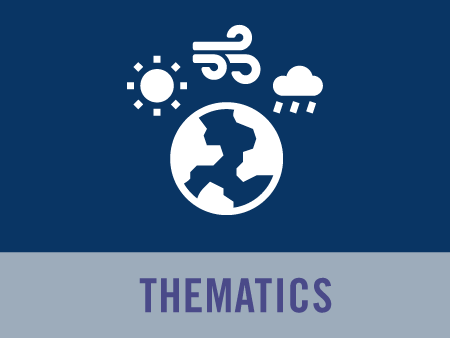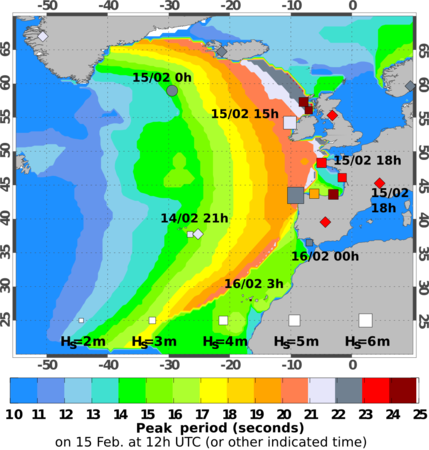Record breaking wave heights and periods in the North Atlantic
February 2011 was extremely stormy in the North Atlantic. A study just published in the Bulletin of American Meteorological Society (December 2012 issue) looks into the anatomy of a record-breaking monster: extra-tropical storm Quirin was caught blowing ocean waves up to significant heights of 20.1 m on February 14 in the middle of the Atlantic...
The new record
The giant waves from Quirin were measured by the radar altimeter onboard the Jason 2 satellite. 20.1 m is the largest significant wave height recorded by a satellite altimeter ever since the first routine space-borne measurements in the late 1980s. The significant wave height is an average of the top third of the highest waves. Although the radar cannot measure individual waves from space, usual statistics tell us that the highest wave in Quirin was probably higher than 36m. Larger waves have probably existed, but we still have not measured them in the open ocean.
Heights ... and periods
Satellite altimeters were not designed to record such high waves and thus we may question the accuracy of the reported value. However, the measurement is consistent with all other measurements, in particular we know that very high waves must have very long periods, a property that is almost conserved as waves disperse in the oceans. Indeed, the Quirin waves turned into extremely long swells with peak periods up to 25 s recorded 2 days later to the North of Ireland.
A surfer's dream and a harbor master nightmare
These long swells can be strongly amplified by underwater reefs, and cause strong long period motions in harbours. Thanks to Quirin, French surfer Benjamin Sanchis rode the 'biggest wave of the year' on February 16 to claim the Billabong XXL prize for 2011, while severe damage was inflicted in Royan harbor du to seiche resonance. The analysis of the storm confirms that the biggest waves appear when the low pressure systems move at the speed of the waves, a phenomenon that is well reproduced by numerical wave models, even for such huge waves. That is if we believe in numerical models for winds: the high winds in the storm center are well observed by modern satellite sensors but the magnitude of measured wind speeds above 50 knots is very uncertain.
More Quirin-like storm in latest years?
It is also the first time that the concurrent analysis of seismic noise shows that noise level at very low periods can be used to identify the biggest waves in the North Atlantic. This will allow researchers to analyse wave climates back in time, before the fairly young era of buoys and satellites, to study if such giant waves are becoming more frequent or not. The "continuous" satellite record that only spans the last 20 years is not sufficient to tell if such extreme waves are more frequent now that 20 years ago, and usual radar satellites only measure wave heights along their track, missing vasts areas of the oceans. Buoys and seismic stations can be used to fill in these gaps because the wave period is more coherent on large scales.
Future satellites on watch
The capability of satellites to estimate wave periods as well as wave heights will be enhanced thanks to improvements in the analysis of radar imagery on the European Space Agency's future Sentinel 1A and 1B missions, and a new type of radar, never put in orbit before, the SWIM instrument on board the future China-France Ocean Satellite. These new sensors will greatly extend today's capabilities and will lead to significant wave forecast improvements.











